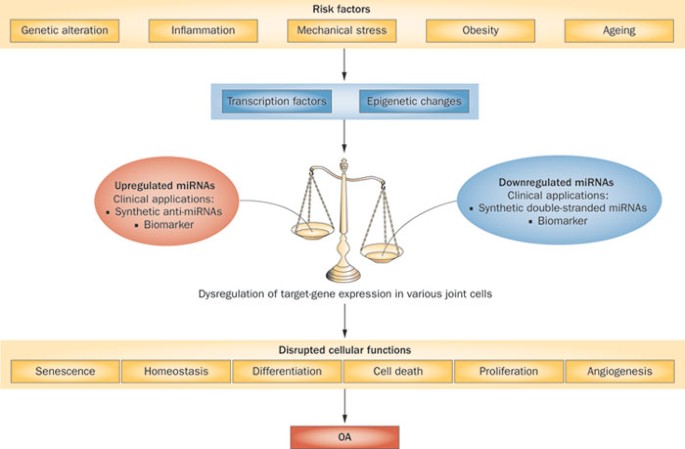Play all audios:
Osteoarthritis (OA), the most common musculoskeletal disorder, is complex, multifaceted, and characterized by degradation of articular cartilage and alterations in other joint tissues.
Although some pathogenic pathways have been characterized, current knowledge is incomplete and effective approaches to the prevention or treatment of OA are lacking. Understanding novel
molecular mechanisms that are involved in the maintenance and destruction of articular cartilage, including extracellular regulators and intracellular signalling mechanisms in joint cells
that control cartilage homeostasis, has the potential to identify new therapeutic targets in OA. MicroRNAs control tissue development and homeostasis by fine-tuning gene expression, with
expression patterns specific to tissues and developmental stages, and are increasingly implicated in the pathogenesis of complex diseases such as cancer and cardiovascular disorders. The
emergent roles of microRNAs in cartilage homeostasis and OA pathogenesis are summarized in this Review, alongside potential clinical applications.
Although some pathogenic pathways in osteoarthritis (OA) have been characterized, effective approaches to prevention or treatment of OA are lacking
Novel genetic regulators, microRNAs (miRNAs), are involved in the development of the musculoskeletal system and OA pathogenesis through maintenance of articular chondrocytes
miRNAs have a role in transmitting the effects of the main risk factors for OA, such as ageing and inflammation, onto cellular homeostasis through their control of multiple target genes
Approaches to maintaining or suppressing the expression of key miRNAs in OA pathogenesis have the potential to identify new therapeutic and diagnostic targets
This work is partly supported by the NIH (USA; grant numbers AR050631 and AR056120), the Arthritis National Research Foundation (USA), Health and Labour Sciences Research Grants (Ministry of
Health, Labour and Welfare, Japan), Grants-in-Aid for Scientific Research (Ministry of Education, Culture, Sports, Science and Technology, Japan), the National Center for Child Health and
Development (Japan; 20A-3) and CREST (Japan Science and Technology Agency).
Department of Regenerative Medicine, Hiroshima University Hospital, 1-2-3 Kasumi, Hiroshima, 734-8551, Japan
Department of Molecular and Experimental Medicine, The Scripps Research Institute, 10550 North Torrey Pines Road, La Jolla, 92037, CA, USA
Both authors contributed equally to researching data for the article, discussing its content, writing and review/editing of the manuscript before publication.
Anyone you share the following link with will be able to read this content:

